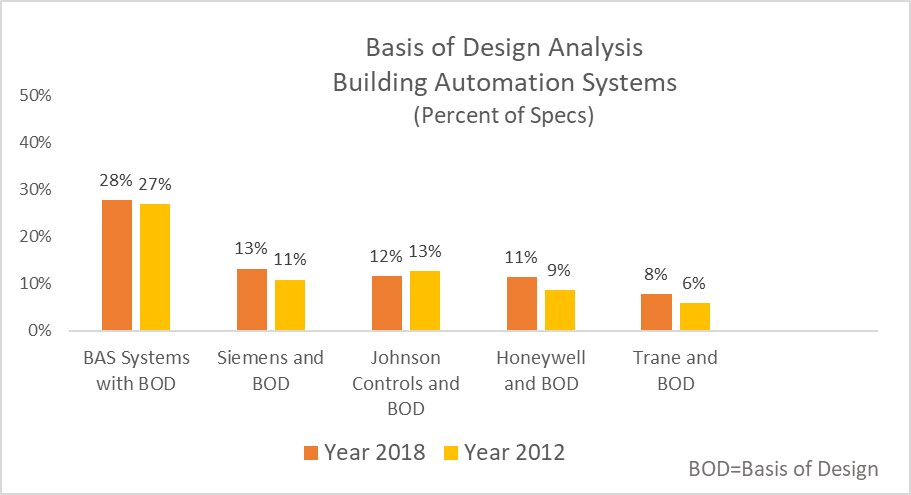
How to Get Building Automation Systems in Specifications
 Building Automation involves bringing mechanical and electrical systems and equipment together with microprocessors in order to communicate with each other and other equipment within a building or campus of buildings. With the advent of IoT, however, their value to building owners and operators is becoming enormous – and thus, specifications will be subject to changes.
Building Automation involves bringing mechanical and electrical systems and equipment together with microprocessors in order to communicate with each other and other equipment within a building or campus of buildings. With the advent of IoT, however, their value to building owners and operators is becoming enormous – and thus, specifications will be subject to changes.
Traditionally out of the realm of a “building,” the BAS changes what the definition of a building really is, and architects are beginning to realize it. Therefore increasingly, manufacturers of such systems must educate the architect on the technology. And while it is not realistic to believe that the architect will become a network integrator, he or she is ultimately responsible for the building’s performance and must possess adequate knowledge for his specifications.
The complexity of such systems, while covered in specifications, is increasingly challenged to keep with the advances of technology[1]. Thus, when it comes to selecting a specific brand for building automation systems (BAS), knowledge of the path to specification is more important than ever.
For example, there are many requirements when it comes to selecting the best building management system for a project. Besides understanding what may or may not already be installed, the manufacturer of such systems must make it a point to gain a thorough understanding of the architect’s role. This includes the “brave new world” that such systems usher in.
The Specification
Most of the specifications for these systems already have very detailed requirements —quality assurance, communications platform, contractor requirements, manufacturer’s service conditions and guarantee to name a few. On the renovation of an existing building or addition, the BAS system brand selection may be limited with a specification that requires the use or interface with existing systems.
For example, language such as this might be required:
Equipment furnished under this section of the Specifications shall be supplied as a complete and functioning system produced under the responsibility of the EMCS Contractor utilizing specified components and any additional components as required to meet the functions and accuracies specified herein.
Or:
The manufacturer shall maintain authorized factory support and an adequate supply of replacement parts for a minimum of ten years from the date of the Owner’s acceptance of the system. The requirement for replacement parts shall apply to all specialty items and proprietary components that are only available from the system manufacturer.
In many cases, language like the following is appearing more than norm:
The BAS shall be comprised of Network Area Controller or Controllers (NAC) within each facility. The NAC shall connect to the owner’s local or wide area network, depending on configuration. Access to the system, either locally in each building, or remotely from a central site or sites, shall be accomplished through standard Web browsers, via the Internet and/or local area network. Each NAC shall communicate to BACnet Building Controllers and other open and legacy protocol systems/devices.
In addition, architects and designers are also acknowledging that the data are part of what must be considered. Who owns it? Does the information collected by a building belong to the building owner or to the manufacturer of the device? Depending on the type of information being distributed, should law enforcement be able to access the data? Who will facility managers want their control points to alert? Movement, like no movement, signals conditions. Whether a fan or tenants in an office, how does a system help employers determine precisely how and where to deploy their attention?
Making an Impact
The brand and product choices designers make in automation systems is dependent on factors such as function, performance, and energy savings. But as discussed, those factors are widening. The brand specified of the BAS system needs to be balanced with meeting the owner’s objectives and long-term goals. Increasingly, language such as the following is included with lists of manufacturers for such systems in specifications:
The manufacturer of the hardware and software components of the BAS shall have a technical support group accessible via a toll-free number that is staffed with qualified personnel, capable of providing instruction and technical support service for networked control systems.
Service has always been important in the specification of MEP; but with automation systems, it is now vital.
In addition, the choice on the BAS system may be controlled (like other building components) by budget requirements and/or analysis of long-term energy and resource savings. According to an earlier Accountability Information Management, Inc. (AIM) preference study, the factors most considered by engineers and architects when selecting a BAS system was the long-term performance and the needs of the client.
But, “long term” for some products has changed because of technology. In the past, that might mean five years. Today, it could be a year before something else shows up to displace the performance of the specified product. That puts architects in a bind with the owners they serve. But, it also opens opportunities for manufacturers to help them cope with not only the changes, but also help deepen the relationship with their clients – by understanding their business well beyond the structure.
We’re All in the Information Business
In the past, designer’s brand specification often required tradeoffs. With many product choices, the final decision depended on how important the system specified will be to the overall success of the project.
Today, the tradeoff is about how much information the owner needs – and wants. Since the BAS system is considered a critical building component, the brand selection requires input from several professionals. The architect, the mechanical engineer and often an engineering “specialist” like an air temperature control engineer, a BAS engineer or integrator, or an optimization engineer all play a role. Many times, with a BAS system, the specification includes proprietary language where a specific brandis required. This means that unless you are specified, your brand is most likely not going to be purchased.
This item has been approved as a proprietary item. No other item will be accepted. Substitution sections of the Contract Documents General Conditions to the Construction Contract do not apply to this item.
Yet, getting on that list might soon require the architect to obtain a deeper knowledge of the owner’s business . For example, it’s no longer adequate to know how many faucets are required by Code on each floor of a building. It’s become more necessary to know what kind of information you want from those faucets. Or Walls. Or doors.
Understanding more about where a manufacturer’s brand falls in the specification processcan ultimately help positively influence the designer’s brand selection and preference for products. Monitoring and measuring shifts in brand specifications year to year gives us clues on how a manufacturer can maximize their visibility and opportunity to be the preferred or in this case the proprietary brand.
Where Should the Manufacturer Focus Their Brand Message?
In a comprehensive Architects’ Brand Preference Study conducted by AIM several years ago, 89% of the architects surveyed did not list a brand for BAS, but indicated the engineer or technical consultant made the brand selection. Only 11% of architects had a brand preference for such systems. But, that’s changing.
The AIM Preference Study was a blind study. That is, architects were not given choices to select from. Rather, they were asked to list their brand preferences, thus giving true insight into how they view brands in their thinking.
By writing in“engineer/consultant” as a brand, they told AIM that BAS was not their priority, but perhaps delegated to a more technical professional. This is not to say that the architect does not have input. In fact, the Brand Preference studies conducted indicated that the architect’s involvement shifted dramatically—24% involved in brand selection in one study, but up to 65% in another study three years later.
Today, we are finding that architects are becoming increasingly involved.
As architects became more familiar with BAS systems and different brands, their preference for one brand over another increased.Therefore, not only do manufacturers need to influence the engineering designer, but the architect as well.
For the architects who indicated they were involved in brand selection, only 2% indicated they did not have a brand preference. For those that had a brand preference, there were only six brands that were listed as a “preference.” These were all large national manufacturers, which indicates the BAS system had a limited competitive field – but one that is growing today as the complexity increases.
Although the frequency of a specific brand mentions may have shifted since these studies, the mindset of the architect still holds true: certain brands are “in their heads” or on their short lists, while others are not. According to the AIM research, there seem to be many factors that manufacturers need to consider when analyzing where they stand in the market and in the minds of architects, especially in relation to perception of brands. Most important, understanding an architect’s level of involvement when specifying particular products is really one of the keys to success in specification.
It is often difficult to know exactly who is making the final decisions on the BAS system. Like many other product categories, BAS involves more than one person. It important to keep all the “influencers” informed on the unique features and benefits of a specific brand.The degree to the architect’s involvement in brand selection varies by many factors, including the type and size of project, location within the facility, geographic location, etc. Ultimately, a BAS system, because it has such a great impact on the long-term function and performance of a building, the facility owner/manager will have a great deal of influence on the brand selected for purchase.
What should BAS manufacturers do to enhance brand selection and preference? How can manufacturers convert an architect’s “no preference” into specifications and recommendations for their brands?
The Basis of Design and BAS
To answer these questions, consider what we know about specifications. The key to gaining ground in specifications and preference is to become a “basis of design.”[2] This means that the architect or designer is calling out a specific brand that should be used to meet the objectives of the project. And while there will inevitably be other manufacturers listed as possibilities, it is the “basis of design” choice that drives the specification. It only makes sense, then, to become the “basis of design” to enhance brand select and preference of a manufacturer’s product.
To learn more about how often “basis of design” is used in BAS specs, AIM used ConstructConnect™, (https://www.constructconnect.com/), an online construction data database to get a better sense of how BAS and brands are specified. By searching project specifications for “BAS/Building Management System projects with Basis of Design” within a specific year we can understand more about how the specification for “basis of design” and specific brands has changed year to year.
Interestingly, only 28% of projects in 2018 that had a BAS specification also included a “basis of design.” This seems to be the general percentage since 2012, where “basis of design” was specified in only 27% of theBAS specifications.
This type of specification analysis can also show manufacturers how often their brand is specified as the “basis of design,” and if it has shifted over a specific period. For example, this analysis shows some brands have made an increase in the specifications where the brand is the “basis of design” verses others where the percent has remained the same.

What that means for BAS manufacturers is the market is constantly changing and affords them an opportunity to gain a leadership position (as no one dominates). It is, therefore, important to monitor where your brand stands in the specification path and take measures to ensure a consistent exposure to architects. Certainly, there is room for growth and theopportunity to reach and influence the specifications is unlimited. However, manufacturers CAN influence the “basis of design” in these specifications, as the data show. Doing that needs to start with controllingand influencing not only the architect’s brand preference but engineer’s and owner’s brand preferences as well. Since the BAS system is critical to the performance of any building, over time manufacturers may also want to look closer at what percent of the project are moving to an approved “proprietary” spec.
Considerations for Helping Architects
Keep in mind that as technology advances, the architect needs to thoroughly understand the implications of BAS, and those who install it. And many larger firms already have processes in place for execution of BAS specifications. All architects need to be familiari with these systems and their growing impact on the structures they design.
Consider the following minimum points as you create a strategy to move toward more “basis of design” specifications.
- Architects are not always used to specifying installation requirements, generally delegating them to the contractor or having the contractor do the recommendations. Help navigate these issues with wording such as, “The Building Automation System BAS system shall be completely installed and placed in operating condition by a BAS Contractor specializing in this type of work.” Also, including wording such as, “The firm shall provide a single source responsibility for all system components, engineering services, maintenance and warranty.”
- Include qualifying requirements in the actual specifications, such as debugging and calibration of the system and all software until the system functions in accordance with specifications. Think about it like commissioning any of the other systems specified, including wording that covers the ongoing maintenance of the system such as, “the final Operational Acceptance Test as witnessed by the Commissioning Agent and the Owner and/or Engineer.
- Additional considerations include:
- Will the facility remain in operation during the entire construction process and during all phases?
- If an existing system is running, will it remain intact, fully operational and will be expanded to include new equipment under the new contract?
- Is the scope of work expanding the existing system, or replacing it? Will it control the Building Addition Heating, Ventilation, and Air Conditioning (HVAC) system equipment, plumbing, other equipment?
- Spell out what the BAS contractor provides, including knowledgeable and qualified personnel to work directly with other contractors (i.e., the air and water Test, Adjust and Balance (TAB) contractor).
- The BAS contractor shall submit to the engineer for review product data sheets for every component used in the project. This is where the architect’s specification are increasingly vital, as components required to “talk to each other” must be outlined and verified.
The BAS contractor is perhaps one of the keys to the success of the BAS. The relationship that contractor builds with the architect is based on providing the owner a BAS that functions and performs as intended. The architect, more than anyone perhaps, needs to know the complexity of such systems more and more, leading to the “basis of design” specifications that become the blueprint of success.
This type of research on “basis of design” can be done on the other product categories besides BAS or on specific brands conducted in the Accountability Architects’ Brand Preference Study. Let us know where your interests are. Thank you for reading.
[1] By 2020, Gartner estimates there will be 25 billion of these smart devices, transmitting tiny amounts of data to us, to the cloud and to each other. Cisco’s outgoing CEO, John Chambers, says there will be 50 billion devices online within five years, with a total market worth $19 trillion. Siemens corporation has said smart things are starting to power a fourth Industrial Revolution (after steam, electricity and wired computers). Source: The Globe and Mail, founded in 1844, Canada’s foremost news media company.
[2] USlegal.com defines it as: “basis of design is a term used in engineering, which typically consists of text paragraphs, preliminary drawings, equipment lists, etc. Well-defined requirements consist of a set of statements that could form the basis of inspection and test acceptance criteria. The basis of design documentation and the specification identify how the design provides the performance and operational requirements of the project and its systems.”